16th JAMCO Online International Symposium
January to March, 2007
Images of Foreign Countries Projected on Television of China, Korea, and Japan
Lecture 3: Observation on the Image of Foreign Countries and Impact of Special Events - From research on "Germany Year in Japan" -
In the JAMCO International Symposium, researchers from the Republic of Korea and China have reported findings on their research and analysis into how the TV media in their respective countries have shown foreign countries. How does Japanese TV media report on other countries?
There are a number of research findings on the image of foreign countries projected in the Japanese TV media, as well as information on other countries, with the ICFP-Japan (International Communication Flow Project-Japan) 1 , to which the author belongs. The group has conducted “surveys on export and import of TV programs in and out of Japan” on three occasions over a span of time from early 1980s until 2001 — each survey taken roughly every 10 years. As part of this research project, TV programs related to other countries, as well as foreign productions, broadcast in Japan have been examined.
In the past surveys, the percentage of foreign-produced programs in Japanese TV programming has remained roughly around 5% in the first through the third surveys. The vast majority of them have been imported from the United States. The percentage of foreign-related elements to be found in Japanese-produced programs was 6.6% in the third survey, falling slightly from 9% in the second. In terms of reference to foreign nations in such programs, the United States account for the overwhelming ratio of reference, as in source of imported programs.2
With the number of television channels multiplying and video distribution on the Web spreading with advances in digital technology, distribution channels for foreign-made and foreign-related programs and videos related to other countries have increased dramatically, and information volume has grow likewise. Still, the powerful influence of terrestrial-way television as the channel for accessing information conveniently and without fees appears to be unaffected significantly for the time being. Also, no dramatic change is seen in the state of programming for foreign-made and foreign-related programs on terrestrial-wave TV.3
Therefore, a case study from a slightly different perspective, examining into the real impact of special events and campaigns on the state of distribution of foreign-related information described above, will be presented here.
” XX Year in Japan”
Special events aimed at promoting bilateral exchange between countries, as well as at enhancing the image of each country among the population in the other, are frequently held under names such as “XX Year in Japan” or “Japan Year in XX.” An Internet search shows that, during the past several years alone, there had been “France Year in Japan” In 1998 (following “Japan Year in France” in the preceding year), “Italy Year in Japan in 2001 (after “Japan Year in Italy” held in 1995 and 1996), “Turkey Year in Japan” in 2003 and “Germany Year in Japan” held from April 2005 until March 2006 (with “Japan Year in Germany” held from 1999 to 2000). That year 2005 was also “Japan-Korea Friendship Year.” In addition, 2006 is reportedly “Japan-Australia Exchange Year,” “Japan-Singapore Tourism Exchange Year” and “Mongolia Year in Japan.”
Of these special events, our research group at ICFP-Japan has studied the “Germany Year in Japan” held from April 2005 to March 2006, examining into how the Japanese media, including TV stations, have reported on Germany. Alongside, two surveys were conducted on public awareness of the “Germany Year” on March 2005 and March 2006, as well as studies on the change in image and awareness toward Germany before and after this special event. 4 Since 2006 was the year of soccer’s World Cup tournament in Germany, a similar study was conducted also in July 2006, after the event closed, covering the impact and effects on the German image after the end of Germany Year and the World Cup.
This report presents the state of broadcasting of TV programs related to the Germany Year and to Germany itself and the findings in public opinion surveys and observations on how the Germany-related event had affected TV coverage of the nation, how it relates to the public image of germany and the degree of influence of Germany Year and FIFA 2006 World Cup Germany on the Japanese perception of the country.
16% of people knew of “Germany Year”
According to the study by our ICFP-Japan research group, people who knew of the event after its closing at end of March 2006 accounted for 16% of the respondents. 5 In the poll conducted at end of March 2006 immediately before start of “Germany Year in Japan”, the percentage was 8%, showing that the recognition rate doubled over a span of one year. Although it is difficult to determine whether 16% is a high recognition level because of the absence of comparable data on similar programs saluting specific nations, the percentage actually exceeds 20% in certain age groups. This may be evidence that this special event was relatively successful in boosting public awareness.
TV ranks at the top as channel for gaining recognition
When the respondents who knew of Germany Year were asked on how they gained the information, the largest number in each of the 3 surveys said information came from television. In the survey conducted before start of Germany Year (hereinafter called “Before Survey”), the percentage of respondents who were aware of the event was only 8%, failing to reach the 10% mark. Of these, 53% said they heard of the event on TV. In the survey conducted after closing of Germany Year (hereinafter called “After Survey”), 64% of those who knew of the event said they obtained information from TV. In the survey after end of 2006 World Cup Germany (hereinafter called “After 2 Survey”), 62% selected TV as the information channel. Data on newspapers, radio, magazines, etc., follows. Although the increase in the percentage of people who obtained information from posters and pamphlets over time is an interesting finding, we have confirmed that TV wields immense power as the media to communicate information on such major special events in every instance.
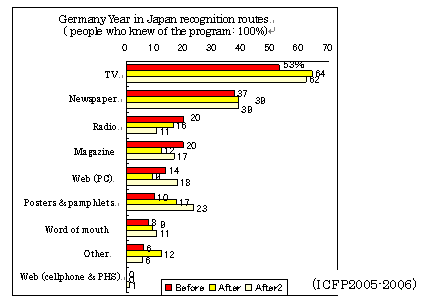
Dramatic rise in Germany-related programs
This report presents a study into the level of Germany-related programming that was broadcast on TV during Germany Year (April 2005-March 2006). 6 However, television news and daytime variety shows were excluded from the study due to limitations in news gathering and analysis. During this period, there were 756 Germany-related programs on Japanese TV (653 hours 38 minutes; 578 hours 59 minutes for Germany-related program segments only), covering a wide spectrum of interests including sports, music, culture and entertainment. Of programs related to Germany, programs on Germany Year numbered 32 (21 hours 14 minutes.
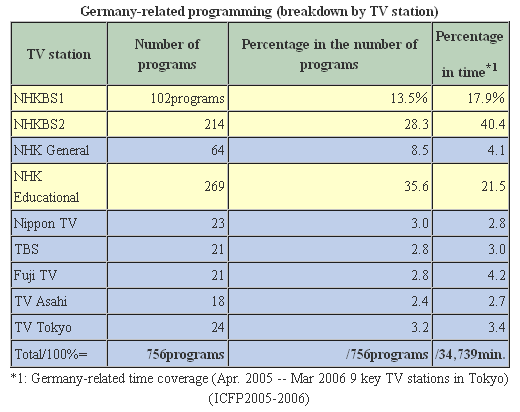
Examples are “Germany Year in Japan Commemorative Program: Shin-ichi Tsutsumi’s Two Weeks in Germany” (Fuji TV), “Concert with No Name: Germany Year Popularity Ranking Top 30” (TV Asahi) and “NHK Music Festival: Bayern Radio Symphony Orchestra” (NHK Educational).
In contrast to programming related to Germany Year in Japan remaining around 32 as mentioned earlier, those featuring the 2006 World Cup Germany already numbered 79 by March 2006, the end of the research period. The number continues to grow until the end of the tournament, long after research was concluded. Unfortunately, we were not able to measure accurately the extent of growth in Germany-related programs on Japanese TV spurred by Germany Year due to absence of data that enables comparison, such as other foreign-related programming during the same period of time and how much Germany-related programs have been broadcast before this commemorative year. For this reason the research group has calculated the airtime for Germany-related programming for the ear of 2002, based on its 2002 survey. 7 According to the findings, German-produced programs accounted for approximately 1275 minutes. Combined with Germany-related programs produced in Japan totaling roughly 6760 minutes, total broadcast time was found to be 8035 minutes. Since the recent survey is restricted to terrestrial-wave television broadcasting, air time for Germany-related programming (Germany-related program segments) during Germany Year on terrestrial-wave TV was calculated and found to be 14,486 minutes. This means that total programming in terms of airtime increased 1.8-fold in the span of one year from April 2005 to March 2006, compared to 8035 minutes in 2002. Since the programming covered in the latest study included a large number of extended specials related to the 2006 World Cup, such as soccer matches and classical music concerts, the growth in terms of air time is believed to be the result of such programming type. However, there is no doubt that a considerable amount of Germany-related programs had been broadcast on Japanese TV in comparison to normal levels of programming in this area.
Many music and culture programs; sports and entertainment attract largest viewership.
In the breakdown of Germany-related programs during the study period by type, many were music programs and accounted for 36% of the total. This is followed by culture-related programs (22%), educational programs (14%), sports (13%), entertainment (7%), drama (5%) and movies (3%). In music programming, many programs featured classical music, and a quarter of the musical compositions performed were works by Beethoven. In culture, programs featured fine arts, travel, and topics related to World War II. Many of the music and culture programs were broadcast by NHK, while roughly half (51 programs) of the total broadcast by private TV stations (107) were entertainment programs.
However, the programs that were most viewed were sports and entertainment programs, rather than music and culture programs. In the calculation of relative viewership by genre, multiplying viewer rating of each program by air time, sports programs ranked at the top in rating, followed by entertainment, culture and motion pictures, in declining order.

Majority have positive image Study was conducted also on the image of the Germany and the German people reported in these programs aired during the study, to see if it worked positively or negatively for Germans.
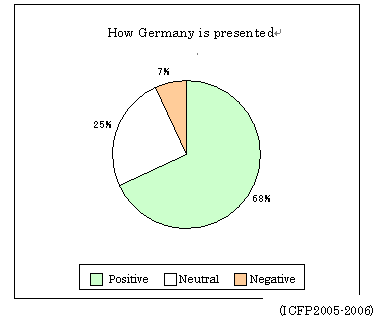
Among the 756 programs, 516 (68%) were identified to project a positive image. This is followed by 189 (25%) determined to be neutral. Those projecting a negative image remained at 7% (51 programs). Most of them were related to Nazi history. However, there had been programs showing German habits and practices that are different from those of Japan for the purpose of comic entertainment and were determined to be negative in impression. Most of the programs related to the Nazis were cultural program in nature, but those showing difference in habits and practices were entertainment programs with a relatively high viewership.
Things associated with Germany
With these many Germany-related programs broadcast in Japan, what impact did they have on the Japanese perception of the “image of Germany”?
In our research project, the German image was studied by presenting identical alternatives in all three surveys conducted, in order to compare changes. There were 14 items associated with the German image, such as “heart of the European Union,” “tourism sites (Romantische Strasse, Rhine River, etc.), “classical composers,” “major economic power,” and “German literature.” Of these, the respondents were asked to choose three that they associate with Germany.
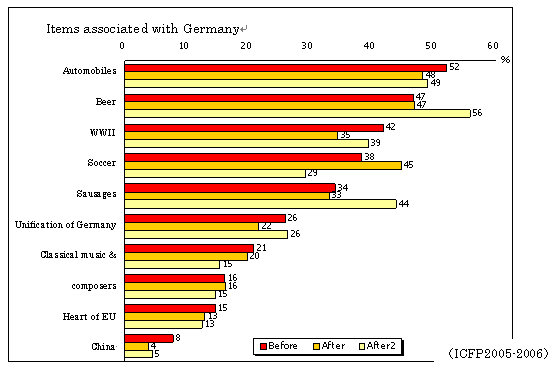
Of the items associated with Germany, “automobiles” ranked at the top in the number of respondent votes in the Before and After surveys, while “beer” was at the top in the After 2 survey.
The top five items in the Before Survey were “automobiles,” “beer,” “World War II,” “soccer” and “sausages,” in declining order. In the After Survey conducted immediately before 2006 World Cup Germany, items at third and fourth places switched, with “soccer” rising to No. 3. However, “soccer” fell sharply to No. 5 in the After 2 Survey, after the World Cup tournament.
In ranking in the After 2 Survey, “beer” jumped over “automobiles” to become No. 1. This is followed by “automobiles,” “sausages,” “World War II” and “soccer.” One element that comes into play in this survey is likely to be that After 2 Survey was conducted in July (season for beer), in contrast to the other surveys (Before and After) that were held at the end of March.
An interesting finding is the change in ranking of “soccer.” This item’s jump in the Before and After surveys clearly was influenced by 2006 World Cup Germany. However, the rapid decline after the tournament was over suggests about the impact of the tournament have been extremely short-lived.
Stubborn stereotypes
Notwithstanding, the top five (automobiles, beer, World War II, soccer and sausages) remained constant in all three surveys. As mentioned earlier, there had been many programs related to Germany broadcast in Japan, vis-à-vis broadcasting exposure on an average year. There was an especially large number of soccer games aired, and viewership was very high. Because of this special event, the Association of Germany with the game of soccer rose rapidly. However, the rise was found to be only transitory and declined with the end of World Cup.
That can be concluded that there was no major change in the stereotypical image of the country commonly linked with “automobiles, beer and sausages.”
According to a German official who was involved in organizing Germany Year in Japan, the organizers have been hoping to do away with the conventional image of Germany (beer, sausages, Nazis, etc.) to be replaced by a new one (innovative advances in science and technology and its pop culture and lifestyles in the fields of fashion, music, etc.) as one of the objectives of the event. 8 Although there have been many events held to achieve this goal, 9 this did not occur at least in TV programming, with such topics and material rarely featured. As far as the opinion surveys show, there had been no substantial change in the image of the country itself. We were not able to confirm change in the latest survey, despite limitations in the range of choices made available in the survey, absence of images peripherally related to typical images and no revisions made in the typical images.
No change in percentage of “people who like Germany”
In the survey, respondents were asked on their “like/dislike of Germany and the German people” and their awareness in German-Japanese relations in the three areas of bilateral relations as a whole, economic relations and cultural exchange.
The findings on “like/dislike of Germany and the German people” are as follows. Although there is a slight growth in the After 2 Survey, it is not significant difference in the statistical perspective. As a result, there was no change in the three surveys.
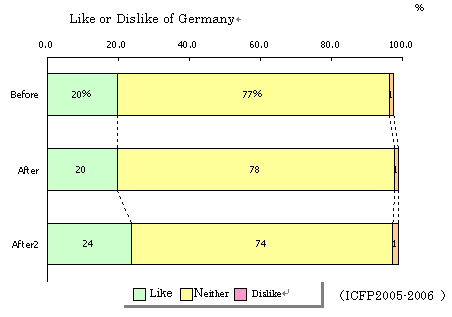
Also, no significant change was found among the three surveys in the area of Japanese awareness of relations with Germany — in bilateral relationship as a whole, in economic relations for cultural exchange — where the roughly 20% perceiving the relationship as good.10
Germany-related news and the German image in the newspaper media
The ICFP-Japan research group also analyzed the content of news articles on Germany and on the German image in 5 national dailies (Asahi Shimbun, Mainichi Shimbun, Yomiuri Shimbun, Sankei Shimbun and Nihon Keizai Shimbun) from April 2005 to March 2006. The trends are shown in summarized form below.
- There was dramatic increase in the number of articles covering Germany Year (especially cultural programs). They have all presented a positive German image.
- There had been a number of factors that triggered increase. They were “60th anniversary of the end of World War II,” “slowdown of the Germany economy,” “German general elections” and others.
- Although the general tone and perspective in the new on Japan was neutral, the general perspective was inclined to be positive.
These results show that the media effect related to Germany Year was stronger from newspapers than TV.
There had also been magazines and books on Germany published in greater number compared to an average year. These facts show that the print media including magazines and books communicated information on Germany on a higher degree compare to an average year and was inclined to present a positive image of the nation. Because the survey asked only on TV program viewing related to world soccer and for channels gaining awareness of Germany Year, resulting from the limited number of questions asked, we were not able to analyzed the relationship between contact with the print media and change in the German image. However, an interesting discovery can be made with follow-up in this area.
Effect and significance of “commemorative year” programs
Summarizing the study findings reported earlier, there had been increase in Germany-related information vis-à-vis average level, on TV and other media. Also, much of the information worked positively for Germany.
Also, Germany Year in Japan programs resulted in wider recognition chiefly through TV.
However, there was no substantial change in Japanese awareness toward bilateral relations with Germany or like/dislike toward Germany and its image. 2006 World Cup Germany spurred a temporary rise in perception, so seating Germany with soccer, but failed to maintain this association after it ended.
Therefore, the findings led to the conclusion that the programs and events organized for Germany Year in Japan and 2006 World Cup Germany had little impact in revamping the image of Germany. It is likely that the influence of such events and promotional campaigns is regarded minimal. But, is it true?
The latest survey coincided with a period that showed an upsurge in programming dealing with Germany Year and the World Cup, making it difficult to isolate the impact of the two major events separately and to measure their strength of impact individually. Still, we were able to confirm that they had contributed to the rise in TV airtime for programming related to Germany.
Out the same time, the survey revealed that increase in programming time did not immediately relate to rise in information made directly accessible to the Japanese in general.
A closer look in to the After 2 Survey regarding viewership of TV programs related to the World Cup, there was a significant difference in viewership of such programs among people who said they “like Germany and the German people” and those who responded “neither like or dislike.” The former group watched soccer games and Germany-related programs more than the latter. In particular, 23% of the respondents who “like Germany and the German people” said that they watched “Germany-related programs other than soccer,” while those classified as “neither like or dislike Germany” accounted for only 7% of such viewers.
As mentioned earlier, there had been a large number of Germany-related music and culture programs during that year covered by the survey. However, there was greater viewership for sports and entertainment programs, which can hardly be regarded a major contributor in communicating the various aspects of the nation.
Because people filter information to access those that attract their interest, as shown above, quantitative increase in information does not necessarily mean proportionate reach into a larger number of people.
It has been set from the pass that media information works in bolstering established image and perceptions rather then change them. The survey findings seem to substantiate this view.
This has also exposed the difficulty of directly affecting the image or perception of a certain country through special events such as commemorative years or through awareness campaigns. Notwithstanding, the absence of such efforts may actually reinforce stereotypical national image and perception toward a specific country, with little change made in media coverage continuing everyday. All the more because of this, these campaigns and events are probably necessary to function as stimuli in increasing opportunities of media exposure and stirring interest of people who are not actively interested, even when immediate effect cannot be expected.
Power of the television
Furthermore, it must be noted that the survey findings also suggest the limitations of special campaigns and events organized by governments and other public organizations in a top-down scheme. The reason is that people do not access information, regardless of the volume of information, if they are not interested.
However, there is a possibility of triggering a boom of unprecedented scale, once interest is ignited. The prime example is the Korea boom that swept Japan in recent years (and is spreading to China and rest of East Asia). Although this popular excitement over Korea was spurred by broadcast of Korea and drama series on NHK’s satellite broadcasting station, it was not planned deliberately to upgrade the image of South Korea. In fact, it was neither a campaign organized by the Korean government nor its diplomatic representatives. The driving force of the boom were middle-aged and older Japanese women who learned of the TV program, with information on the series and featured actors spreading by word-of-mouth and growing into a social phenomenon involving other media and other generations in Japan. 11 The program also affected the Japanese perception of Korea. According to a survey by NHK Broadcasting Culture Research Institute, people who watched “Winter Sonata” rose to 38% of the entire Japanese population. Of these, 22% said the drama series has “increased interest in Korea,” and 26% said “their image of Korea changed.” 12 Continued research is necessary on the power and maintenance of reach in the study of relationship between the Korea boom and change in the Korean image. Still, it is a case that strongly impressed of the immense power of television.
Conclusion
There are many issues that require research in the area of the TV media and image of foreign nations, such as the impact of international events such as “commemorative years” and international sport events such as the World Cup and the Olympics on media content, how the change in content affect public perception of the country in question and how different the influence of such an event is compared to success of TV drama or motion picture. Because of the differences in relations between Japan and a foreign nation that underlie each case, whether it is a special year dedicated to a nation, and international sport event or specific TV program or film, it is extremely difficult to place such cases on an equal footing and conduct comparative study. Still, we believe it is necessary to examine carefully into each case and build up knowledge regarding these relations. Accumulation of case studies will certainly lead to exposure of trends that are shared in common by many nations and to revelation of distinctive features and characteristics by nation or region. Research on Germany Year in Japan came as a result of request from the Embassy of the Federal Republic of Germany to cooperate in research. Because of the need of a wide range of resources, including budget, equipment and manpower required for data gathering and analysis, in organizing a comprehensive and systematic study into influence of this type, it is a fact that many difficulties and problems are involved in implementation, despite the fact that accumulating case studies are important as mentioned earlier. In this respect, the author acknowledges gratitude for making this study into the Germany Year possible and would like to express hope that the research findings will contribute as a case study of value to research in this area in the future.
Material
- Renamed ICFP-Japan in 2000, it was previously known as ITFP-Japan (International Television Flow Project-Japan). Since its formation in 1979, it has engaged in a wide range of research related to international communication and information distribution and their relationship with the media.
- Hara Yumiko, Kawatake Kazuo & Sugiyama, Akiko, “The Cosmopolitan Quality of Japanese TV Programming: Research Findings on the International Flow of TV Programs,” NHK Broadcasting Culture Research Institute Annual No. 48, 2004.
- With the Korean drama boom triggered by “Winter Sonata” that began airing in April 2003, regular programming of Korean-made drama series on private terrestrial-wave broadcasting stations pushed up the volume of foreign-made program broadcast temporarily. As of 2006, however, regular broadcast of such programs have dropped, returning to the status of Japanese TV program prior to the Korea boom.
- This research project was subsidized by the Embassy of the Federal Republic of Germany in Tokyo and the Hoso-Bunka Foundation, Inc. Additional cooperation in the public poll survey has been provided by Video Research, Ltd.
- Due to the limitations of the survey (covering Tokyo area within 30-kilometer radius and respondents being men and women aged from 13 to 59), it must be noted that the data presented does not reflect awareness and perceptions of the Japanese population as a whole.
- The study covered nine TV channels — NHK General, NHK Educational, Nippon Television, TBS, Fuji Television, TV Asahi, TV Tokyo and NHK BS 1 and 2. News gathering was conducted from April 2005 to March 2006.
- Same as Note 2
- Comment by Dr. Uwe Schmelter (Geothe-Institut Tokyo), who participated in planning Germany Year in Japan (“Image of Germany Reported in the Media,” ICFP Meeting held on October 28, 2006)
- According to the Germany Year in Japan official website, there had been just short of 1600 programs and events involved. http://www.doitsu-nen.jp
- Although the percentage is roughly identical at around 20%, the respondents that gave positive replies (of liking Germany, feeling close, cooperative, etc.) are not necessarily the same people.
- Hayashi Kaori(?), “The Political Factor in “Winter Sonata” Drama Series: Emotions and Lifestyles of Women and Japan-Korea Relations,” Information Science Research Issue No. 69, Graduate School of Interdisciplinary Information Studies, the University of Tokyo; “Reading from the Gender Perspective: Current State of “Korea Boom” Culture,” Gender Research, Josai International University, Gendai Shokan, 2006, etc.
- Mitsuya, Keiko, “Winter Sonata Phenomenon from the Standpoint of Opinion Polls: Surveys on Winter Sonata,” Broadcasting Research & Survey December issue, 2004.
Yumiko Hara
NHK Broadcasting Culture Research Institute
Deputy Director, Research and Survey Division, Broadcasting Culture Research Institute, Japan Broadcasting Corporation (NHK) Graduated from Sophia University, Department of French Culture Working at NHK Broadcasting Culture Research Institute since 1978 Main research themes are research on effects on internationalism and international understanding of TV programs Research on people's information actions and TV viewing actions, etc.
 Return to 16th JAMCO Online International Symposium contents page
Return to 16th JAMCO Online International Symposium contents page








